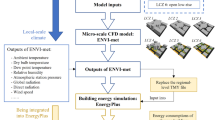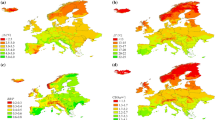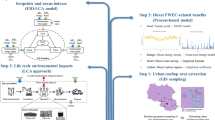Abstract
Cities around the globe search for solutions to tackle the challenges of climate resilience and energy consumption. The potential of green roofs representing a nature-based solution in mitigating urban heat and related energy consumption at the urban scale is given limited attention. Here we apply a comprehensive framework integrating urban climate modeling, urban building energy modeling and statistical analysis with empirical data to address this research gap through a case study in Seoul. The findings highlight that the efficacy of nonirrigated extensive green roofs is significantly influenced by meteorological conditions, underscoring the importance of considering those factors in green-roof design and implementation. Moreover, the cooling effect of green-roof implementation at the urban scale causes monthly urban building energy use intensity reductions of up to 0.64 kWh m−2 (7.7%). The insights from this research have broad implications for cities around the world experiencing the challenges imposed by urban heat.
This is a preview of subscription content, access via your institution
Access options
Subscribe to this journal
Receive 12 digital issues and online access to articles
$119.00 per year
only $9.92 per issue
Buy this article
- Purchase on Springer Link
- Instant access to full article PDF
Prices may be subject to local taxes which are calculated during checkout






Similar content being viewed by others
Data availability
The ERA-Interim reanalysis dataset for WRF simulations was accessed from https://rda.ucar.edu/datasets/ds627.0/dataaccess/. Building properties such as total floor area, height and number of floors, essential for the development of the urban building energy model, were collected from the official building registry (https://open.eais.go.kr/main/main.do). The monthly records of gas and electricity consumption for Seoul were accessed from the local online repository66. The AWS meteorological data were downloaded from the Korea Meteorological Administration (KMA) database59. Source data are provided with this paper.
Code availability
The analysis of urban climate conditions was performed using the WRF model (version 4.3). The latest version of the WRF modeling system’s source code can be obtained from the public WRF-Release page on GitHub, accessible at https://github.com/wrf-model/WRF/releases. The UBEM was performed using CitySim Pro software (version as of 3 May 2021), developed at EPFL. The tool can be accessed from its official website at http://www.kaemco.ch/download.php. The results were graphed using OriginPro (version 2022b 9.9.5.167 (Academic)). The Python (version 3.10.9) script used for WRF output processing and conversion is available at the repository with identifier https://doi.org/10.6084/m9.figshare.24998669.
References
Tuholske, C. et al. Global urban population exposure to extreme heat. Proc. Natl Acad. Sci. USA 118, e2024792118 (2021).
Santamouris, M. Analyzing the heat island magnitude and characteristics in one hundred Asian and Australian cities and regions. Sci. Total Environ. 512–513, 582–598 (2015).
Santamouris, M. & Kolokotsa, D. On the impact of urban overheating and extreme climatic conditions on housing, energy, comfort and environmental quality of vulnerable population in Europe. Energy Build. 98, 125–133 (2015).
Sakka, A., Santamouris, M., Livada, I., Nicol, F. & Wilson, M. On the thermal performance of low income housing during heat waves. Energy Build. 49, 69–77 (2012).
Pantavou, K., Theoharatos, G., Mavrakis, A. & Santamouris, M. Evaluating thermal comfort conditions and health responses during an extremely hot summer in Athens. Build. Environ. 46, 339–344 (2011).
Pantavou, K., Theoharatos, G., Santamouris, M. & Asimakopoulos, D. Outdoor thermal sensation of pedestrians in a Mediterranean climate and a comparison with UTCI. Build. Environ. 66, 82–95 (2013).
Singh, M. & Sharston, R. Quantifying the dualistic nature of urban heat island effect (UHI) on building energy consumption. Energy Build. 255, 111649 (2022).
Skelhorn, C. P., Levermore, G. & Lindley, S. J. Impacts on cooling energy consumption due to the UHI and vegetation changes in Manchester, UK. Energy Build. 122, 150–159 (2016).
Santamouris, M. Recent progress on urban overheating and heat island research. Integrated assessment of the energy, environmental, vulnerability and health impact. Synergies with the global climate change. Energy Build. 207, 109482 (2020).
Santamouris, M., Cartalis, C., Synnefa, A. & Kolokotsa, D. On the impact of urban heat island and global warming on the power demand and electricity consumption of buildings—a review. Energy Build. 98, 119–124 (2015).
Silva, C. M., Gomes, M. G. & Silva, M. Green roofs energy performance in Mediterranean climate. Energy Build. 116, 318–325 (2016).
Alim, M. A. et al. Green roof as an effective tool for sustainable urban development: an Australian perspective in relation to stormwater and building energy management. J. Clean. Prod. 362, 132561 (2022).
Getter, K. L., Rowe, D. B. & Andresen, J. A. Quantifying the effect of slope on extensive green roof stormwater retention. Ecol. Eng. 31, 225–231 (2007).
Akther, M., He, J., Chu, A., Huang, J. & van Duin, B. A review of green roof applications for managing urban stormwater in different climatic zones. Sustainability 10, 2864 (2018).
Shafique, M., Kim, R. & Kyung-Ho, K. Green roof for stormwater management in a highly urbanized area: the case of Seoul, Korea. Sustainability 10, 584 (2018).
Wadhwa, A. & Pavan Kumar, K. Selection of best stormwater management alternative based on storm control measures (SCM) efficiency indices. Water Policy 22, 702–715 (2020).
Guan, M., Sillanpää, N. & Koivusalo, H. Assessment of LID practices for restoring pre-development runoff regime in an urbanized catchment in Southern Finland. Water Sci. Technol. 71, 1485–1491 (2015).
Mentens, J., Raes, D. & Hermy, M. Green roofs as a tool for solving the rainwater runoff problem in the urbanized 21st century? Landsc. Urban Plan. 77, 217–226 (2006).
Czemiel Berndtsson, J. Green roof performance towards management of runoff water quantity and quality: a review. Ecol. Eng. 36, 351–360 (2010).
Fassman-Beck, E., Voyde, E., Simcock, R. & Hong, Y. S. 4 living roofs in 3 locations: does configuration affect runoff mitigation? J. Hydrol. 490, 11–20 (2013).
Hashemi, S. S. G., Mahmud, H. B. & Ashraf, M. A. Performance of green roofs with respect to water quality and reduction of energy consumption in tropics: a review. Renew. Sustain. Energy Rev. 52, 669–679 (2015).
Berardi, U., GhaffarianHoseini, A. H. & GhaffarianHoseini, A. State-of-the-art analysis of the environmental benefits of green roofs. Appl. Energy 115, 411–428 (2014).
Mahdiyar, A. et al. Probabilistic private cost–benefit analysis for green roof installation: a Monte Carlo simulation approach. Urban For. Urban Green. 20, 317–327 (2016).
Susca, T. Green roofs to reduce building energy use? A review on key structural factors of green roofs and their effects on urban climate. Build. Environ. 162, 106273 (2019).
Getter, K. L. & Rowe, D. B. The role of extensive green roofs in sustainable development. HortScience 41, 1276–1285 (2006).
Parizotto, S. & Lamberts, R. Investigation of green roof thermal performance in temperate climate: a case study of an experimental building in Florianópolis City, Southern Brazil. Energy Build. 43, 1712–1722 (2011).
Klein, P. M. & Coffman, R. Establishment and performance of an experimental green roof under extreme climatic conditions. Sci. Total Environ. 512–513, 82–93 (2015).
Tang, M. & Zheng, X. Experimental study of the thermal performance of an extensive green roof on sunny summer days. Appl. Energy 242, 1010–1021 (2019).
Santamouris, M. et al. Investigating and analysing the energy and environmental performance of an experimental green roof system installed in a nursery school building in Athens, Greece. Energy 32, 1781–1788 (2007).
Karachaliou, P., Santamouris, M. & Pangalou, H. Experimental and numerical analysis of the energy performance of a large scale intensive green roof system installed on an office building in Athens. Energy Build. 114, 256–264 (2016).
Hu, Y., Dai, Z. & Guldmann, J.-M. Modeling the impact of 2D/3D urban indicators on the urban heat island over different seasons: a boosted regression tree approach. J. Environ. Manag. 266, 110424 (2020).
Boafo, F. E., Kim, J. T. & Kim, J. H. Evaluating the impact of green roof evapotranspiration on annual building energy performance. Int. J. Green Energy 14, 479–489 (2017).
Chagolla-Aranda, M. A. et al. Effect of irrigation on the experimental thermal performance of a green roof in a semi-warm climate in Mexico. Energy Build. 154, 232–243 (2017).
Jaffal, I., Ouldboukhitine, S. E. & Belarbi, R. A comprehensive study of the impact of green roofs on building energy performance. Renew. Energy 43, 157–164 (2012).
Li, D., Bou-Zeid, E. & Oppenheimer, M. The effectiveness of cool and green roofs as urban heat island mitigation strategies. Environ. Res. Lett. 9, 055002 (2014).
Tan, H., Ray, P., Tewari, M., Brownlee, J. & Ravindran, A. Response of near-surface meteorological conditions to advection under impact of the green roof. Atmosphere 10, 759 (2019).
Wang, X., Li, H. & Sodoudi, S. The effectiveness of cool and green roofs in mitigating urban heat island and improving human thermal comfort. Build. Environ. 217, 109082 (2022).
Adilkhanova, I., Santamouris, M. & Yun, G. Y. Coupling urban climate modeling and city-scale building energy simulations with the statistical analysis: climate and energy implications of high albedo materials in Seoul. Energy Build. 290, 113092 (2023).
He, Y., Yu, H., Dong, N. & Ye, H. Thermal and energy performance assessment of extensive green roof in summer: a case study of a lightweight building in Shanghai. Energy Build. 127, 762–773 (2016).
Jim, C. Y. & Peng, L. L. H. Weather effect on thermal and energy performance of an extensive tropical green roof. Urban For. Urban Green 11, 73–85 (2012).
Lee, L. S. H. & Jim, C. Y. Thermal-cooling performance of subtropical green roof with deep substrate and woodland vegetation. Ecol. Eng. 119, 8–18 (2018).
Lin, B. S., Yu, C. C., Su, A. T. & Lin, Y. J. Impact of climatic conditions on the thermal effectiveness of an extensive green roof. Build. Environ. 67, 26–33 (2013).
Castleton, H. F., Stovin, V., Beck, S. B. M. & Davison, J. B. Green roofs; building energy savings and the potential for retrofit. Energy Build. 42, 1582–1591 (2010).
D’Orazio, M., Di Perna, C. & Di Giuseppe, E. Green roof yearly performance: a case study in a highly insulated building under temperate climate. Energy Build. 55, 439–451 (2012).
Hekrle, M., Liberalesso, T., Macháč, J. & Matos Silva, C. The economic value of green roofs: a case study using different cost–benefit analysis approaches. J. Clean. Prod. 413, 137531 (2023).
Perini, K. & Rosasco, P. Cost–benefit analysis for green façades and living wall systems. Build. Environ. 70, 110–121 (2013).
Teotónio, I., Silva, C. M. & Cruz, C. O. Eco-solutions for urban environments regeneration: the economic value of green roofs. J. Clean. Prod. 199, 121–135 (2018).
Niu, H., Clark, C., Zhou, J. & Adriaens, P. Scaling of economic benefits from green roof implementation in Washington, DC. Environ. Sci. Technol. 44, 4302–4308 (2010).
Shin, E. & Kim, H. Benefit–cost analysis of green roof initiative projects: the case of Jung-gu, Seoul. Sustainability 11, 3319 (2019).
Graceson, A., Monaghan, J., Hall, N. & Hare, M. Plant growth responses to different growing media for green roofs. Ecol. Eng. 69, 196–200 (2014).
Wu, A. N. & Biljecki, F. Roofpedia: automatic mapping of green and solar roofs for an open roofscape registry and evaluation of urban sustainability. Landsc. Urban Plan. 214, 104167 (2021).
Kusaka, H., Kondo, H., Kikegawa, Y. & Kimura, F. A simple single-layer urban canopy model for atmospheric models: comparison with multi-layer and slab models. Boundary-Layer Meteorol. 101, 329–358 (2001).
Lim, S.-Y. H. & Jade, J.-O. The WRF single-moment 6-class microphysics scheme (WSM6). J. Korean Meteorol. Soc. 42, 129–151 (2006).
Kain, J. S. The Kain–Fritsch convective parameterization: an update. J. Appl. Meteorol. 43, 170–181 (2004).
Dudhia, J. Numerical study of convection observed during the winter monsoon experiment using a mesoscale two-dimensional model. J. Atmos. Sci. 46, 3077–3107 (1989).
Mlawer, E. J., Taubman, S. J., Brown, P. D., Iacono, M. J. & Clough, S. A. Radiative transfer for inhomogeneous atmospheres: RRTM, a validated correlated-k model for the longwave. J. Geophys. Res. Atmos. 102, 16663–16682 (1997).
Hong, S.-Y., Noh, Y. & Dudhia, J. A new vertical diffusion package with an explicit treatment of entrainment processes. Mon. Weather Rev. 134, 2318–2341 (2006).
Chen, F. & Dudhia, J. Coupling an advanced land surface–hydrology model with the Penn State–NCAR MM5 Modeling System. Part I: model implementation and sensitivity. Mon. Weather Rev. 129, 569–585 (2001).
Meteorological Data Open Portal. Korea Meteorological Administration https://data.kma.go.kr/cmmn/main.do (2022).
Carbonell, L. T. et al. Assessment of the weather research and forecasting model implementation in Cuba addressed to diagnostic air quality modeling. Atmos. Pollut. Res. 4, 64–74 (2013).
Bilang, R. G. J. P., Blanco, A. C., Santos, J. A. S. & Olaguera, L. M. P. Simulation of urban heat island during a high-heat event using WRF urban canopy models: a case study for metro Manila. Atmosphere 13, 1658 (2022).
Rooftop Greening Support Project (in Korean). Seoul Research Institute https://seoulsolution.kr/ko/content/3066 (2015).
Youngho, K. & Kyu, C. S. A study for the building rooftop utilization—focusing on the rooftop space in Seoul (in Korean). Architecture & Urban Research Institute (2015).
Yang, J. et al. Enhancing hydrologic modelling in the coupled weather research and forecasting–urban modelling system. Boundary-Layer Meteorol. 155, 87–109 (2015).
Yang, J. & Wang, Z. H. Physical parameterization and sensitivity of urban hydrological models: application to green roof systems. Build. Environ. 75, 250–263 (2014).
Public Data Portal. Korea Information Society Agency https://www.data.go.kr/index.do (2021).
Wang, S., Yan, C. & Xiao, F. Quantitative energy performance assessment methods for existing buildings. Energy Build. 55, 873–888 (2012).
Su, M. A., Ngarambe, J., Santamouris, M. & Yun, G. Y. Empirical evidence on the impact of urban overheating on building cooling and heating energy consumption. iScience 24, 102495 (2021).
Acknowledgements
This research was supported by the Basic Science Research Program through the National Research Foundation of Korea (NRF) funded by the Ministry of Education (no. 2020R1A2C1099611, G.Y.Y.). This work was supported by the National Research Foundation of Korea (NRF) grant funded by the Korean government (MSIT) (no. RS-2023-00217322, G.Y.Y.).
Author information
Authors and Affiliations
Contributions
I.A.: conceptualization, methodology, investigation, formal analysis, visualization, writing—original draft, and writing—review and editing. M.S.: conceptualization, methodology, supervision, and writing—review and editing. G.Y.Y.: conceptualization, methodology, funding acquisition, supervision, writing—original draft, and writing—review and editing.
Corresponding author
Ethics declarations
Competing interests
The authors declare no competing interests.
Peer review
Peer review information
Nature Cities thanks Marcel Ignatius, Abhinav Wadhwa and the other, anonymous, reviewer(s) for their contribution to the peer review of this work.
Additional information
Publisher’s note Springer Nature remains neutral with regard to jurisdictional claims in published maps and institutional affiliations.
Supplementary information
Supplementary Information
Supplementary Figs. 1–3, Table 1 and Methods.
Source data
Source Data Figs. 1–6
Statistical source data.
Rights and permissions
Springer Nature or its licensor (e.g. a society or other partner) holds exclusive rights to this article under a publishing agreement with the author(s) or other rightsholder(s); author self-archiving of the accepted manuscript version of this article is solely governed by the terms of such publishing agreement and applicable law.
About this article
Cite this article
Adilkhanova, I., Santamouris, M. & Yun, G.Y. Green roofs save energy in cities and fight regional climate change. Nat Cities 1, 238–249 (2024). https://doi.org/10.1038/s44284-024-00035-7
Received:
Accepted:
Published:
Issue Date:
DOI: https://doi.org/10.1038/s44284-024-00035-7



